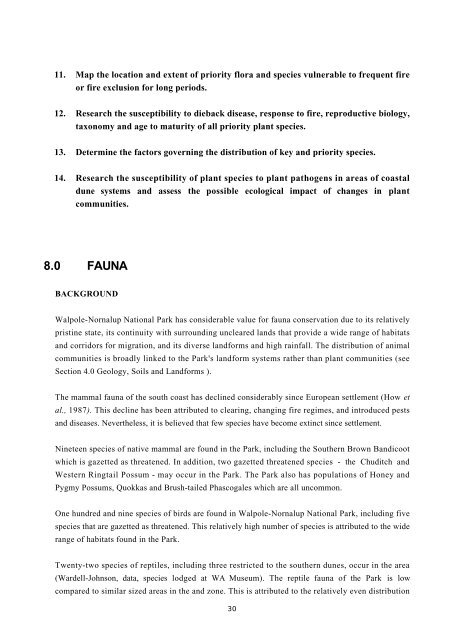Walpole-Nornalup National Park - Department of Environment and ...
Walpole-Nornalup National Park - Department of Environment and ...
Walpole-Nornalup National Park - Department of Environment and ...
Create successful ePaper yourself
Turn your PDF publications into a flip-book with our unique Google optimized e-Paper software.
11. Map the location <strong>and</strong> extent <strong>of</strong> priority flora <strong>and</strong> species vulnerable to frequent fire<br />
or fire exclusion for long periods.<br />
12. Research the susceptibility to dieback disease, response to fire, reproductive biology,<br />
taxonomy <strong>and</strong> age to maturity <strong>of</strong> all priority plant species.<br />
13. Determine the factors governing the distribution <strong>of</strong> key <strong>and</strong> priority species.<br />
14. Research the susceptibility <strong>of</strong> plant species to plant pathogens in areas <strong>of</strong> coastal<br />
dune systems <strong>and</strong> assess the possible ecological impact <strong>of</strong> changes in plant<br />
communities.<br />
8.0 FAUNA<br />
BACKGROUND<br />
<strong>Walpole</strong>-<strong>Nornalup</strong> <strong>National</strong> <strong>Park</strong> has considerable value for fauna conservation due to its relatively<br />
pristine state, its continuity with surrounding uncleared l<strong>and</strong>s that provide a wide range <strong>of</strong> habitats<br />
<strong>and</strong> corridors for migration, <strong>and</strong> its diverse l<strong>and</strong>forms <strong>and</strong> high rainfall. The distribution <strong>of</strong> animal<br />
communities is broadly linked to the <strong>Park</strong>'s l<strong>and</strong>form systems rather than plant communities (see<br />
Section 4.0 Geology, Soils <strong>and</strong> L<strong>and</strong>forms ).<br />
The mammal fauna <strong>of</strong> the south coast has declined considerably since European settlement (How et<br />
al., 1987). This decline has been attributed to clearing, changing fire regimes, <strong>and</strong> introduced pests<br />
<strong>and</strong> diseases. Nevertheless, it is believed that few species have become extinct since settlement.<br />
Nineteen species <strong>of</strong> native mammal are found in the <strong>Park</strong>, including the Southern Brown B<strong>and</strong>icoot<br />
which is gazetted as threatened. In addition, two gazetted threatened species - the Chuditch <strong>and</strong><br />
Western Ringtail Possum - may occur in the <strong>Park</strong>. The <strong>Park</strong> also has populations <strong>of</strong> Honey <strong>and</strong><br />
Pygmy Possums, Quokkas <strong>and</strong> Brush-tailed Phascogales which are all uncommon.<br />
One hundred <strong>and</strong> nine species <strong>of</strong> birds are found in <strong>Walpole</strong>-<strong>Nornalup</strong> <strong>National</strong> <strong>Park</strong>, including five<br />
species that are gazetted as threatened. This relatively high number <strong>of</strong> species is attributed to the wide<br />
range <strong>of</strong> habitats found in the <strong>Park</strong>.<br />
Twenty-two species <strong>of</strong> reptiles, including three restricted to the southern dunes, occur in the area<br />
(Wardell-Johnson, data, species lodged at WA Museum). The reptile fauna <strong>of</strong> the <strong>Park</strong> is low<br />
compared to similar sized areas in the <strong>and</strong> zone. This is attributed to the relatively even distribution<br />
30

















